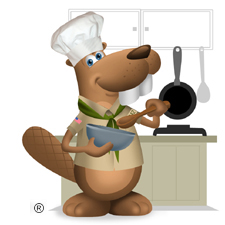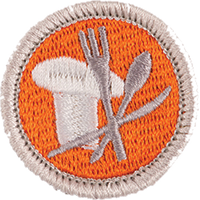Cooking


Resources
- Cooking Merit Badge Pamphlet
- Cooking Merit Badge Class Preparation Page
- Cooking Merit Badge Workbook
- Scoutmaster Bucky's Merit Badge Advancement Quick Reference
- Scoutmaster Bucky's Acknowledgement Form
Related
Cooking Requirements
Current Scouts BSA requirements
as of December 6, 2025
as of December 6, 2025
Note: The meals prepared for Cooking merit badge requirements 4, 5, and
6 will count only toward fulfilling those requirements and will not count
toward rank advancement or other merit badges. Meals prepared for rank
advancement or other merit badges may not count toward the Cooking merit
badge. You must not repeat any menus for meals actually prepared or cooked
in requirements 4, 5, and 6.
Outdoor Cooking: Where local regulations do not allow you to build a
fire, the counselor may adjust the requirement to meet the law. The meals
in requirements 5 and 6 may be prepared for different trips and need not be
prepared consecutively. Scouts working on this badge in summer camp should
take into consideration foods that can be obtained at the camp
commissary.
1.
Health and safety. Do the following:
a.
Explain to your counselor the most likely hazards you may encounter
while participating in cooking activities and what you should do to
anticipate, help prevent, mitigate, and respond to these hazards.
b.
Show that you know first aid for and how to prevent injuries or
illnesses that could occur while preparing meals and eating, including
burns and scalds, cuts, choking, and allergic reactions.
c.
Describe how meat, fish, chicken, eggs, dairy products, and fresh
vegetables should be stored, transported, and properly prepared for
cooking. Explain how to prevent cross-contamination.
d.
Discuss with your counselor food allergies, food intolerance, and
food-related illnesses and diseases. Explain why someone who handles or
prepares food needs to be aware of these concerns.
e.
Discuss with your counselor why reading food labels is important.
Explain how to identify common allergens such as peanuts, tree nuts,
milk, eggs, wheat, soy, and shellfish.
2.
Nutrition. Do the following:
a.
Using the MyPlate food guide or the current USDA nutrition model, give
five examples for EACH of the following food groups, the recommended
number of daily servings, and the recommended serving size:
1.
Fruits
2.
Vegetables
3.
Grains
4.
Proteins
5.
Dairy.
b.
Explain why you should limit your intake of oils and sugars.
c.
Track your daily level of activity and your daily caloric need based on
your activity for five days. Then, based on the MyPlate food guide,
discuss with your counselor an appropriate meal plan for yourself for
one day.
d.
Discuss your current eating habits with your counselor and what you can
do to eat healthier, based on the MyPlate food guide.
e.
Discuss the following food label terms: calorie, fat, saturated
fat, trans fat, cholesterol, sodium, carbohydrate, dietary fiber,
sugar, and protein. Explain how to calculate total carbohydrates
and nutritional values for two servings, based on the serving size
specified on the label.
3.
Cooking Basics. Do the following:
a.
Discuss the following cooking methods. For each one, describe the
equipment needed, how temperature control is maintained, and name at
least one food that can be cooked using that method: baking, boiling,
broiling, pan frying, simmering, microwaving, air frying, grilling,
foil cooking, and Dutch oven.
b.
Discuss the benefits of using a camp stove on an outing vs. a charcoal
or wood fire.
c.
Describe for your counselor how to manage your time when preparing a
meal so components for each course are ready to serve at the correct
time.
d.
Explain and give examples of how taste, texture, and smell impact what
we eat.
4.
Cooking at Home. Do the following:
Note: The meals for requirement 4 may be prepared on different
days, and they need not be prepared consecutively. The requirement calls
for Scouts to plan, prepare, and serve one breakfast, one lunch, and one
dinner to at least one adult; those served need not be the same for all
meals.
a.
Using the MyPlate food guide or the current USDA nutrition model, plan
menus for three full days of meals (three breakfasts, three lunches,
and three dinners) plus one dessert. Your menus should include enough
to feed yourself and at least one adult, keeping in mind any special
needs (such as food allergies) and how you keep your foods safe and
free from cross-contamination. List the equipment and utensils needed
to prepare and serve these meals.
b.
Find recipes for each meal. Create a shopping list for your meals
showing the amount of food needed to prepare for the number of people
you will serve. Determine the cost for each meal.
c.
Share and discuss your meal plan and shopping list with your counselor.
d.
Using at least five of the 10 cooking methods from requirement 3,
prepare and serve yourself and at least one adult (parent, family
member, guardian, or other responsible adult) one breakfast, one lunch,
one dinner, and one dessert from the meals you planned.
e.
Time your cooking to have each meal ready to serve at the proper time.
Have an adult verify the preparation of the meal to your counselor.
f.
After each meal, ask a person you served to evaluate the meal on
presentation and taste, then evaluate your own meal. Discuss what you
learned with your counselor, including any adjustments that could have
improved or enhanced your meals. Tell how planning and preparation help
ensure a successful meal.
5.
Camp Cooking. Do the following:
a.
Using the MyPlate food guide or the current USDA nutrition model, plan
a menu that includes four meals, one snack, and one dessert for your
patrol (or a similar size group of up to eight youth, including you) on
a camping trip. These four meals must include two breakfasts, one
lunch, and one dinner. Additionally, you must plan one snack and one
dessert. Your menus should include enough food for each person, keeping
in mind any special needs (such as food allergies) and how you keep
your foods safe and free from cross-contamination. List the equipment
and utensils needed to prepare and serve these meals.
b.
Find or create recipes for the four meals, the snack, and the dessert
you have planned. Adjust menu items in the recipes for the number to be
served. Create a shopping list and budget to determine the per-person
cost.
c.
Share and discuss your menu plans and shopping list with your
counselor.
d.
In the outdoors, using your menu plans and recipes for this
requirement, cook two of the four meals you planned using either a camp
stove OR backpacking stove. Use a skillet OR a Dutch oven over campfire
coals for the third meal, and cook the fourth meal in a foil pack OR on
a skewer. Serve all of these meals to your patrol or a group of youth.
e.
In the outdoors, using your menu plans and recipes for this
requirement, prepare one snack and one dessert. Serve both of these to
your patrol or a group of youth.*
f.
After each meal, have those you served evaluate the meal on
presentation and taste, and then evaluate your own meal. Discuss what
you learned with your counselor, including any adjustments that could
have improved or enhanced your meals. Tell how planning and preparation
help ensure successful outdoor cooking.
g.
Lead the clean-up of equipment, utensils, and the cooking site
thoroughly after each meal. Properly store or dispose unused
ingredients, leftover food, dishwater and garbage.
h.
Discuss how you followed the Leave No Trace Seven Principles and the
Outdoor Code when preparing your meals.
6.
Trail and backpacking meals. Do the following:
a.
Using the MyPlate food guide or the current USDA nutrition model, plan
a day of meals for trail hiking or backpacking that includes one
breakfast, one lunch, one dinner, and one snack. These meals must
consider weight, not require refrigeration and are to be consumed by
three to five people (including you). List the equipment and utensils
needed to prepare and serve these meals.
b.
Create a shopping list for your meals, showing the amount of food
needed to prepare and serve each meal, and the cost for each meal.
c.
Share and discuss your menu and shopping list with your counselor.
Your plan must include how to repackage foods for your hike or
backpacking trip to eliminate as much bulk, weight, and garbage as
possible.
d.
While on a trail hike or backpacking trip, prepare and serve two
meals and a snack from the menu planned for this requirement. At least
one of those meals must be cooked over a fire, or an approved trail
stove (with proper supervision).
e.
After each meal, have those you served evaluate the meal on
presentation and taste, then evaluate your own meal. Discuss what you
learned with your counselor, including any adjustments that could have
improved or enhanced your meals. Tell how planning and preparation help
ensure successful trail hiking or backpacking meals.
f.
Explain to your counselor how you should divide the food and cooking
supplies among the patrol in order to share the load. Discuss how to
properly clean the cooking area and store your food to protect it from
animals.
7.
Careers and Hobbies. Do ONE of the following:
a.
Identify three career opportunities that would use skills and knowledge
in cooking. Pick one and research the training, education,
certification requirements, experience, and expenses associated with
entering the field. Research the prospects for employment, starting
salary, advancement opportunities and career goals associated with this
career. Discuss what you learned with your counselor and whether you
might be interested in this career.
b.
Identify how you might use the skills and knowledge in cooking to
pursue a personal hobby or healthy lifestyle. Research the additional
training required, expenses, and affiliation with organizations that
would help you maximize the enjoyment and benefit you might gain from
it. Discuss what you learned with your counselor and share what
short-term and long-term goals you might have if you pursued this.